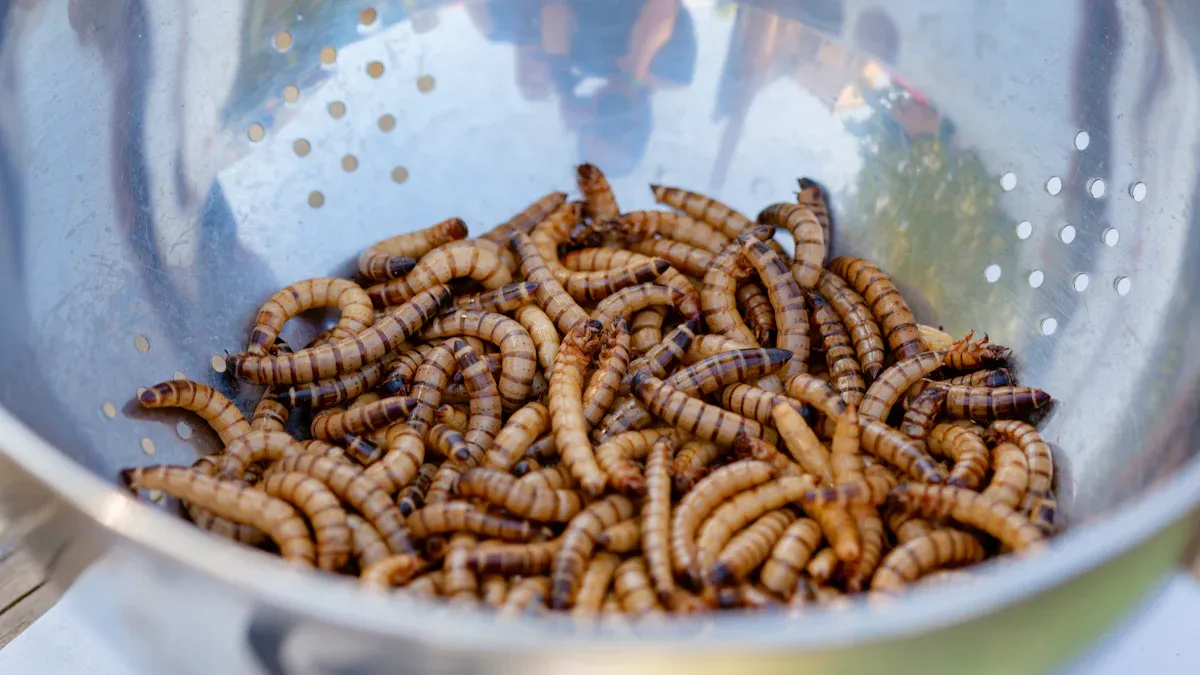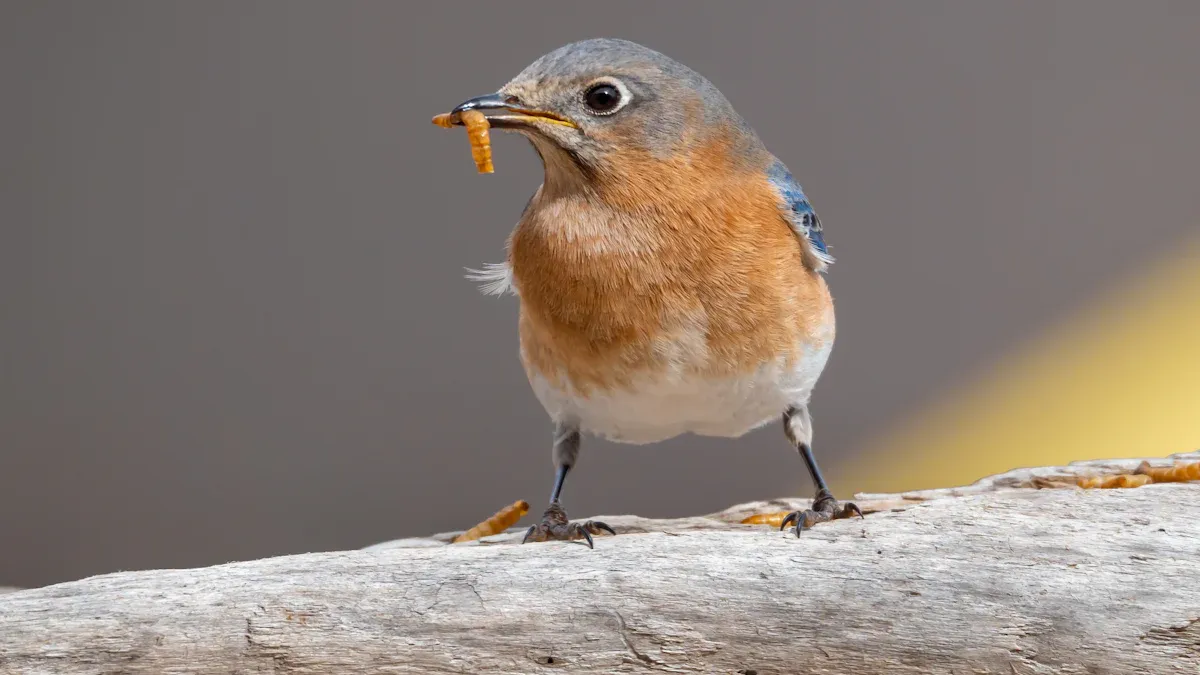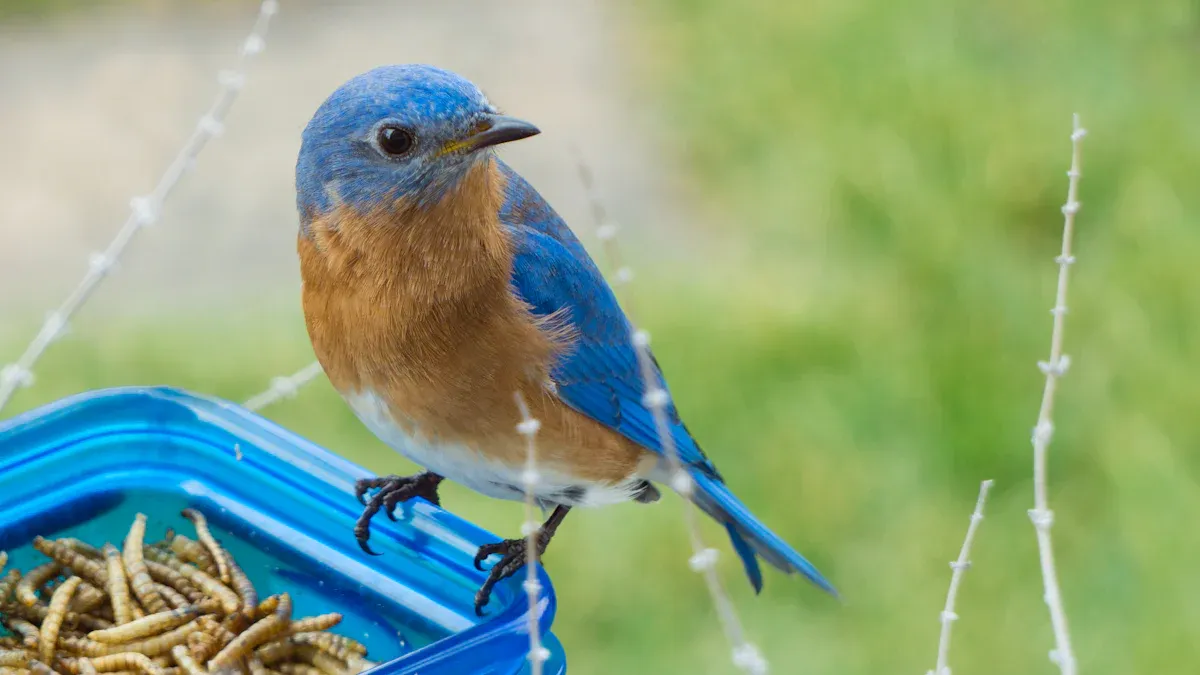
Imagine turning your backyard into a lively haven for birds. Meal Worm Bird Food is a game-changer. Packed with nutrients, it gives birds the energy they need to thrive. Plus, it attracts a variety of species, adding color and life to your space. Why not give it a try today?
Key Takeaways
- Mealworms are healthy food for birds, giving them protein and fat. These nutrients help birds grow, especially during nesting time.
- Feeding mealworms brings many bird types to your yard. This makes your backyard lively with chirping and flying birds.
- Storing live or dried mealworms the right way keeps them fresh. Fresh mealworms make it simple to help birds all year.
Why Choose Mealworm Bird Food?
Nutritional Benefits for Birds
Mealworms are like a superfood for birds. They’re packed with protein, which helps birds stay strong and healthy. Protein is especially important during nesting season when birds need extra energy to care for their young. Mealworms also contain fat, which gives birds the fuel they need to fly, forage, and stay warm in colder months.
Think of it this way: feeding birds mealworms is like giving them a power-packed snack. It’s not just about survival—it’s about helping them thrive. Plus, mealworms are a natural food source that many birds would eat in the wild. By offering them in your backyard, you’re giving birds exactly what they need to stay active and vibrant.
How Mealworms Enhance Bird Activity
Adding mealworms to your bird-feeding routine can turn your backyard into a lively bird paradise. Birds love mealworms, and once they discover them, they’ll keep coming back for more. You’ll notice more chirping, fluttering, and playful behavior as birds gather to enjoy their treat.
Mealworms also attract a variety of species. From robins to bluebirds, many birds can’t resist this tasty snack. This means you’ll get to enjoy watching different types of birds up close. It’s like having a front-row seat to nature’s show!
팁: Place your mealworms in a visible spot to help birds find them faster. Once they know where to look, they’ll visit your yard regularly.
By using Meal Worm Bird Food, you’re not just feeding birds—you’re creating a space where they can thrive and bring joy to your outdoor space.
Birds Attracted to Mealworm Bird Food

Common Backyard Birds
Mealworms are a favorite snack for many common backyard birds. You’ll likely see robins, bluebirds, and chickadees flocking to your yard once you start offering them. These birds love the protein-packed treat and will quickly make your backyard their go-to spot. Cardinals and wrens might also join the feast, adding even more color and charm to your outdoor space.
If you’re lucky, you might even spot woodpeckers enjoying the mealworms. They’re not just for small birds—larger species find them irresistible too. Watching these birds interact and feed can be a delightful experience. It’s like having your own nature documentary right outside your window!
팁: Place the mealworms in a shallow dish or specialized feeder to make it easy for birds to access them.
Seasonal Visitors
Mealworms don’t just attract year-round residents. They’re also a magnet for seasonal visitors. During spring and summer, you might notice migratory birds like orioles and warblers stopping by for a quick snack. These birds rely on high-energy foods like mealworms to fuel their long journeys.
In colder months, mealworms can help sustain birds like juncos and sparrows that stick around during winter. Offering Meal Worm Bird Food during these times can make a big difference for birds when natural food sources are scarce. It’s a simple way to support your feathered friends throughout the year.
Fun Fact: Birds remember reliable food sources. Once they find your mealworms, they’ll keep coming back!
Live vs. Dried Mealworms

Benefits of Live Mealworms
Live mealworms are a favorite among birds. Their natural movement grabs attention, making them irresistible to your feathered visitors. Birds like bluebirds, robins, and wrens especially love live mealworms because they mimic the insects they’d find in the wild.
Offering live mealworms can also encourage nesting birds to visit your yard. They’re an excellent source of protein for growing chicks. Plus, watching birds hunt and peck at live mealworms adds a fun, interactive element to your backyard birdwatching experience.
팁: Place live mealworms in a smooth-sided dish to keep them from crawling away.
Benefits of Dried Mealworms
Dried mealworms are a convenient alternative. They don’t require refrigeration and are easy to store. You can keep them on hand year-round, making them perfect for busy bird enthusiasts.
Birds still enjoy dried mealworms, even though they lack the movement of live ones. They’re just as nutritious and provide the same protein boost. Dried mealworms are also less messy, making them a great option for feeders near patios or windows.
Did you know? You can soak dried mealworms in water to make them softer and more appealing to birds.
Storage and Care Tips
For live mealworms, keep them in a cool, dry place like a refrigerator. This slows their growth and keeps them fresh longer. Use a breathable container with some bran or oats as bedding.
Dried mealworms are even easier to store. Keep them in an airtight container in a cool, dry spot. This prevents moisture and keeps them fresh for months.
Whether you choose live or dried, Meal Worm Bird Food is a fantastic way to attract and nourish birds in your backyard.
Tips for Using Mealworm Bird Food
Best Practices for Feeding Mealworms
Feeding mealworms to birds is simple, but a few tips can make it even better. Start by offering small amounts. Birds will quickly find the food, and you can adjust the quantity based on how much they eat. Place the mealworms in a shallow dish or feeder. This keeps them contained and easy for birds to access.
Timing matters too. Early morning is the best time to put out mealworms. Birds are most active then and need energy to start their day. If you’re using live mealworms, keep them in a shaded spot to prevent them from overheating.
팁: Avoid overfeeding. Too many mealworms can spoil or attract pests.
Making Mealworms More Appealing
Sometimes birds need a little encouragement to try something new. You can make mealworms more appealing by mixing them with other bird foods. Sprinkle them alongside seeds or suet to catch a bird’s attention.
If you’re using dried mealworms, try soaking them in water for a few minutes. This softens them and makes them more like live ones. Birds love the texture and will flock to your feeder.
Fun Fact: Birds are curious creatures. Once one bird tries the mealworms, others will follow!
Choosing the Right Feeder
The right feeder can make all the difference. Look for a feeder designed for mealworms. These often have smooth sides to keep live mealworms from escaping. A platform feeder or a shallow dish works well for dried mealworms.
Place the feeder in a visible spot, like near a tree or shrub. Birds feel safer when they can quickly fly to cover. Keep the feeder clean to prevent mold or bacteria from building up.
Pro Tip: Experiment with feeder placement. Move it around until you find the spot birds love most.
Storing Mealworms Properly
Live Mealworm Storage
Keeping live mealworms fresh and healthy is easier than you might think. You’ll need a breathable container, like a plastic tub with small air holes. Add a layer of bran or oats as bedding, and toss in a few slices of carrot or potato for moisture. These steps create a cozy environment for your mealworms.
Store the container in a cool, dry place—your refrigerator works perfectly. The cold slows their growth and keeps them from turning into beetles too quickly. Just make sure the temperature stays between 40°F and 50°F.
팁: Check on your mealworms every few days. Replace old bedding and remove any dead ones to keep the container clean.
If you’re planning to feed birds, scoop out only what you need. This way, you’ll avoid waste and keep the rest fresh for longer.
Dried Mealworm Storage
Dried mealworms are even simpler to store. You don’t need refrigeration, which makes them super convenient. Keep them in an airtight container to protect them from moisture. A pantry or cupboard works great, as long as it’s cool and dry.
Pro Tip: Use a resealable bag or jar to keep pests away.
Dried mealworms can last for months if stored properly. Check the packaging for expiration dates, but they usually stay fresh for a long time. If you notice any odd smells or discoloration, it’s time to toss them out.
By storing mealworms the right way, you’ll always have a reliable food source for your feathered friends.
Mealworms are a fantastic way to bring life and color to your backyard. They provide birds with essential nutrients, attract a variety of species, and create a lively, thriving ecosystem.
Why wait? Start adding mealworms to your feeders today. You’ll not only enjoy the beauty of nature but also help support bird populations in your area.
팁: A small step like this can make a big difference for your feathered friends! 🐦
제품 정보
How often should I feed birds mealworms?
You can offer mealworms daily, especially during nesting or migration seasons. Start with small amounts and adjust based on how quickly birds eat them.
팁: Morning is the best time to feed birds since they’re most active then.
다른 새 음식을 섞을 수 있습니까?
Yes! Mixing mealworms with seeds or suet can attract more birds. It’s a great way to introduce mealworms to birds unfamiliar with them.
Are mealworms safe for all birds?
Mealworms are safe for most birds, but avoid overfeeding. Too many can upset a bird’s diet balance. Offer them as a treat alongside other food sources.
참고 : Always keep feeders clean to ensure bird health.


